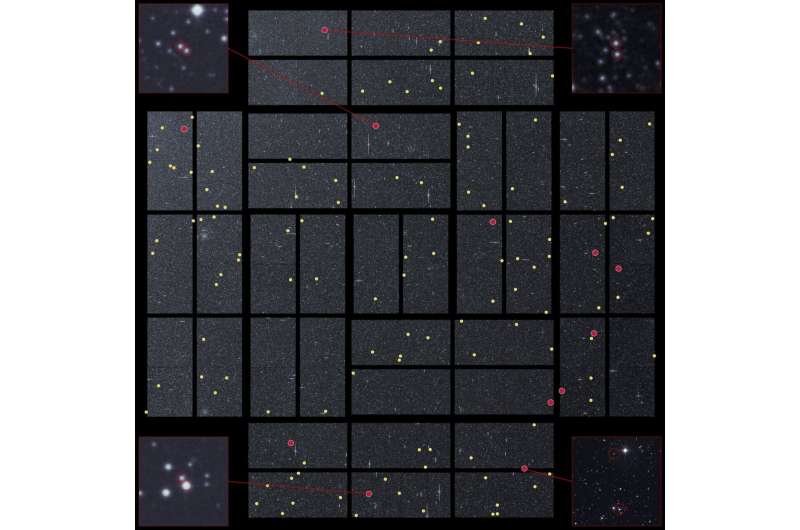This article has been reviewed according to Science X's editorial process and policies. Editors have highlighted the following attributes while ensuring the content's credibility:
fact-checked
peer-reviewed publication
trusted source
proofread
Study demonstrates consistency of rotational evolution between open cluster and field stars for determining age

Scientists at the Leibniz Institute for Astrophysics Potsdam (AIP) and Boston University have successfully established a connection between the rotation rates of stars in star clusters and those outside them, so-called field stars, enabling the ages of the latter to be derived.
The results show that the method of gyrochronology can be applied not only to cluster stars, but also works well for field stars, and thus the ages of many more stars can be determined. The findings are published in the journal Astronomy & Astrophysics.
How old is a star? This is a tricky question, and it is easier to answer for a star that resides in a star cluster. This is because all stars in a star cluster—no matter their size—have the same origin and thus the same age. By studying the collective properties of stars in a cluster and their current stages of evolution, one can obtain a good estimate of their age.
Researchers are now exploring the new field of gyrochronology which enables the ages of individual stars to be determined. It establishes a relationship between the rotation of a star and its color as well as its age.
The rotation period with which a star spins around its axis can be determined from observations of its brightness: many stars have dark spots on their surface, much like the sun's sunspots. When a star rotates and a starspot moves into an observer's field of view, the brightness of the star decreases by a small amount. By measuring these small dips in the intensity of the star's light and when they repeat, for instance with data from the Kepler satellite, as was used here, the rotation period of a star can be measured.
Studies of low-mass dwarf stars in clusters have shown that stars rotate increasingly slower as they age. Plotting the rotation periods of stars against their colors in a diagram, a characteristic pattern emerges: the cluster stars form curves that collectively define a skeleton of rotational evolution, with each rib of the skeleton corresponding to a cluster of a particular age, and clusters of older ages successively defining the higher ribs. Each rib is then a curve of equal age.
By plotting a cluster star in the diagram, its age can be derived using these lines. However, since this method was developed on the basis of star clusters, it was not clear until now whether this method of age determination also works for stars that are outside clusters, and which constitute the overwhelming majority of our galaxy's stars.
This is where the recent work comes in. The authors worked with a sample of more than 300 wide binary stars. These are systems of two stars that orbit around each other and are sufficiently distant from one another not to have interacted and so disturbed their normal rotational evolution.
Wide binary stars are field stars but their common origin allows one assumption also used for cluster stars—that they are of the same age. This means that if field stars do in fact evolve the same way as cluster stars, then the two stars of a wide binary should provide a consistent picture if placed onto the cluster skeleton. In other words, if one star of a wide binary lies on a particular cluster's rotational rib, would the other also lie on the same rib? The authors of the study found that this is emphatically the case.
In fact, the authors found that they could split the examined binary stars into a series of subgroups, each associated with a corresponding cluster of the appropriate age. David Gruner, lead author of the study and Ph.D. student at AIP in the Stellar Activity group, says, "It was surprising to see how well all of our wide binary systems fell into place when we began to compare them to the cluster skeleton. Even systems with stars of very different masses showed remarkable coherence in their locations in the diagram, to the point that they are virtually indistinguishable from the clusters."
The few stars lying above the collection of cluster ribs can then be presumed to be older than the clusters that have been measured to date. Furthermore, the authors showed that for the vast majority of the systems studied, the rotational age of one component matches the rotational age of the other component. Because the wide binary sample was very diverse, both in its distribution across the sky and in its other stellar properties, such as metal content, the result implies that gyrochronology can likely be used reliably for field stars.
Dr. Sydney Barnes, head of the Stellar Activity group at AIP, adds, "The work provides a measure of assurance that in the future reliable ages for much greater numbers of field stars can be obtained from their rotation rates." This result will be of importance to the PLATO satellite mission, which aims not only to discover large numbers of planet-hosting stars, but also to provide their ages, enabling the first glimpses into the evolutionary history of exoplanets.
More information: D. Gruner et al, Wide binaries demonstrate the consistency of rotational evolution between open cluster and field stars, Astronomy & Astrophysics (2023). DOI: 10.1051/0004-6361/202346590
Journal information: Astronomy & Astrophysics
Provided by Leibniz Institute for Astrophysics Potsdam




















